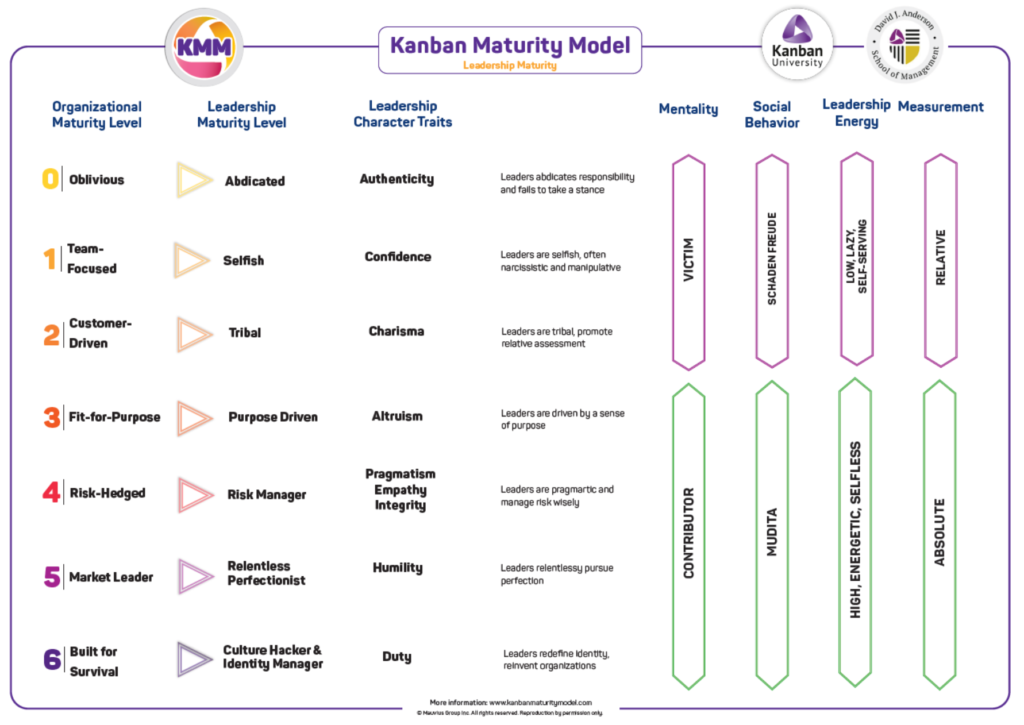Understanding the Leadership Maturity Model: A Path to Effective Leadership
Leadership is a dynamic and evolving skill set that develops over time. The Leadership Maturity Model (LMM) provides a way of understanding the different stages of leadership maturity, helping leaders identify where they stand and what they need to do to grow. This model encompasses six levels, each representing a distinct stage in a leader’s development. Understanding this model is essential for anyone looking to grow as a leader or to develop their team’s leadership capabilities.

Why is the Leadership Maturity Model Important?
- Enhanced Self-Awareness: The LMM helps you identify where you currently stand as a leader. By understanding your strengths and areas for improvement, you can create a personalized development plan to enhance your skills.
- Improved Team Dynamics: Leaders who comprehend their maturity level can better support their teams, fostering a culture of growth and collaboration. Recognizing the maturity levels of your team members enables you to provide tailored guidance, promoting a more cohesive work environment.
- Strategic Decision-Making: The LMM equips leaders with the knowledge to align their strategies with organizational goals. Understanding your maturity level allows you to make informed decisions that drive effectiveness and success.
- Empowerment of Future Leaders: As you develop your leadership skills, you create opportunities for your team members to grow into future leaders. A strong leadership pipeline is crucial for long-term organizational success, and the LMM provides a roadmap for nurturing that talent.
A Look At Each Level
Here’s a breakdown of each level and what it means to lead effectively at that stage:
Level 0: Leaderless Chaos
At this foundational level, there is no clear leadership or direction. Teams may lack cohesion, and decision-making can be arbitrary or nonexistent. Leaders at this level may struggle with accountability and responsibility, leading to confusion and inefficiency. To progress, there needs to be an acknowledgment of the need for leadership and a willingness to establish structure.
Level 1: Emerging Leader
Emerging leaders begin to take on responsibilities and demonstrate basic leadership qualities. They are often focused on managing tasks and maintaining order within the team. At this level, leaders are learning to communicate effectively, build trust, and motivate their team members. Progressing to Level 2 involves developing a deeper understanding of team dynamics and enhancing interpersonal skills.
Level 2: Functional Leader
Functional leaders understand their roles and responsibilities and can manage their teams effectively. They focus on optimizing processes and achieving specific outcomes. This level emphasizes the importance of collaboration, as functional leaders start to build relationships across different teams. To advance to Level 3, leaders need to cultivate strategic thinking and a broader organizational perspective.
Level 3: Strategic Leader
Strategic leaders possess a strong vision for the future and align their teams toward achieving organizational goals. They excel in decision-making, problem-solving, and fostering innovation. At this level, leaders are not only concerned with their team’s immediate tasks but also consider the long-term impact of their actions on the organization. To move to Level 4, leaders must enhance their ability to inspire and engage others while navigating complex challenges.
Level 4: Transformational Leader
Transformational leaders drive change and inspire their teams to reach new heights. They are focused on creating a positive organizational culture and fostering a sense of belonging among team members. These leaders are adept at mentoring and developing future leaders. The shift to Level 5 requires them to deepen their emotional intelligence and understand the nuances of organizational dynamics, leading to greater impact.
Level 5: Visionary Leader
Visionary leaders are influential figures who shape the direction of their organizations. They have a clear understanding of market trends and leverage their insights to drive innovation. At this level, leaders cultivate a culture of empowerment and collaboration, encouraging their teams to take ownership of their work. Transitioning to Level 6 involves embracing a transformative approach, challenging the status quo, and redefining identities.
Level 6: ML6 Leader (Maturity Level 6)
At the pinnacle of the Leadership Maturity Model, ML6 leaders are agents of profound change. They reinvent organizations and challenge existing norms, focusing on identity and values. These leaders possess resilience and tenacity, often making difficult decisions that may not be immediately recognized or understood. They have the vision to see beyond the present and the ability to inspire others to embrace a new way of thinking. Their leadership is characterized by a commitment to inclusivity, innovation, and a relentless pursuit of excellence.
Conclusion
The Leadership Maturity Model provides a roadmap for leaders at all stages of their development. By understanding the characteristics and challenges associated with each level, leaders can identify their strengths and areas for improvement. Embracing this model encourages continuous growth and fosters an environment where effective leadership can thrive, ultimately leading to healthier teams and more successful organizations. Whether you’re just starting your leadership journey or are striving to reach the highest levels of maturity, recognizing the stages of leadership can empower you to make impactful changes and inspire those around you.
Take Action: Elevate Your Leadership Skills
Understanding the Leadership Maturity Model is just the beginning. To truly harness its potential and elevate your leadership capabilities, consider exploring our Kanban Leadership Professional courses. These courses are designed to provide you with the tools and knowledge necessary to advance through the Leadership Maturity Model, equipping you to lead with confidence and purpose.





